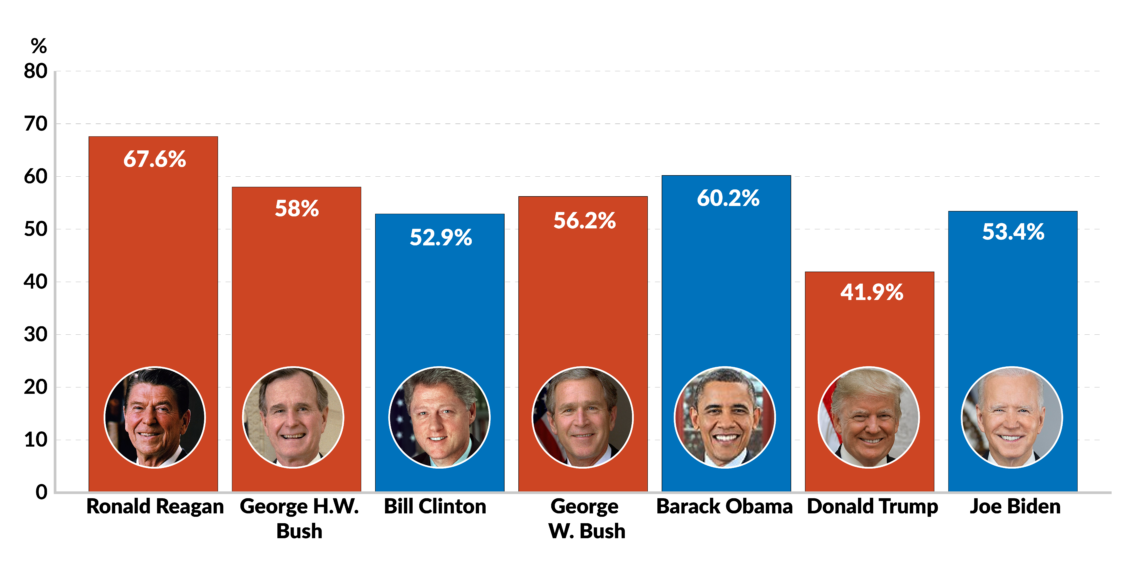The Biden Doctrine: A work in progress
While President Joe Biden has changed the tone of U.S. foreign policy, his actual positions are a mix of those from the Trump and Obama eras. The hodgepodge is the result of a focus on domestic legislation that could make America vulnerable.

In a nutshell
- Joe Biden is conducting a mixed foreign policy
- His administration’s main focus is on domestic issues
- The White House is likely to take a ‘risk avoidance’ strategy
Some presidents of the United States enter office without a coherent vision for protecting the country’s global interests, and Joe Biden appears to be one such leader. While he struck a different tone as promised, the policies behind the rhetorical shifts reflect a patchwork of concerns and influences, including both elements of continuity and change from the previous administration of President Donald Trump. In the end, the Biden team’s approach to foreign policy will probably look remarkably like those of the Barack Obama administration, in which Biden served as vice president.
Behind the climate initiatives
Foreign policy was not a significant issue in the 2020 elections. As a candidate, Mr. Biden emphasized his experience and contrasting style of leadership, but offered few detailed proposals. He did, however, lay out a few priorities. These included rejoining the Paris Agreement, recommitting to the Joint Comprehensive Plan of Action (JCPOA, known as the Iran deal) and reorganizing operations on the U.S. border with Mexico. Each of these either supported his domestic agenda or appealed to distinct constituencies among the president’s supporters. They are not necessarily indicative of the larger foreign policy direction.
Rejoining the Paris Agreement and associated actions, such as President Biden’s U.S.-led Major Economies Forum (MEF) on Energy and Climate with dozens of foreign leaders, is a case in point. These actions are widely hailed as a U.S. effort to demonstrate multinational leadership on climate policy. The rationale behind the move may be more prosaic. The administration sees highlighting global cooperation on climate change as providing added authority for driving domestic initiatives on the U.S.’s “nationally determined contribution” (NDC) – the domestic plan to reduce carbon emissions and adapt to the effects of climate change.
Only about six percent of the funding in the Biden administration’s infrastructure bill pertains to traditional infrastructure.
The Biden administration has unveiled what it has dubbed an infrastructure initiative, called the American Jobs Plan. Along with some upgrading of traditional infrastructure, it is also designed to achieve energy and climate goals. In practice the act is even more expansive, advancing a sweeping progressive political agenda that addresses the priorities of many liberal constituencies.
More than 25 percent of the funding advances progressive healthcare and welfare measures, while according to some calculations, only about six percent pertains to roads and bridges. This legislative initiative suggests, at least in part, that the administration is promoting global climate initiatives as justification for its ambitious domestic social and economic goals, not primarily as a foreign policy objective.
Focus on domestic priorities
Besides a flurry of activity here or there, other hot button foreign policy issues have not been a central focus for the Biden administration. The emphasis on events at home is not unusual. New presidents often put most of their effort into their domestic agenda when they enter office – especially in the first 100 days, a period that has taken on special significance since President Franklin Roosevelt (1933-1945) coined the term during his very active first year. In this period, administrations will often harness foreign affairs to support internal policies and satisfy various constituencies, or push them to the side while seeking to cement their domestic agenda.
The first 100 days proved particularly attractive for the Biden team to try and accomplish its goals. The president’s party controls both houses of Congress, albeit narrowly. Recent polls show most Americans approve of his performance, although by smaller margins than other recent presidents in their first 100 days (surpassing only President Trump and President Bill Clinton).
Facts & figures

The administration has argued that the Covid-19 pandemic demands bold action. In addition to a $1.9 trillion relief package (signed into law in March 2021) and the introduction of the proposed $2 trillion Americans Jobs Plan, the Biden White House has also put forward the American Families Plan, which addresses education, childcare, healthcare, paid family leave and anti-poverty measures at a cost of about $1.8 trillion. It has also supported a sweeping bill directing changes to national elections. Though the president did not fully implement the full scope of his agenda in the first hundred days, his team introduced all its major initiatives and is pressing to implement them long before attention turns to the 2022 midterm elections.
Foreign and security policy
No administration can ignore foreign affairs. Yet the Biden team has not set out any major foreign policy initiative that signals a clear direction. Rather, decisions appear to reflect a mixture of voices.
Defense spending is a case in point. On one hand, the administration acknowledges the importance of a strong national defense in an era of great power competition. On the other, a significant Congressional faction in the president’s own party pressed for a 10 percent decrease in the defense budget. According to media reports, the president had to settle the debate over the top-line defense figure, calling for a modest increase in the budget that did not account for inflation.
The Asia-Pacific region offers another interesting area of policy development. The administration’s stated approach for dealing with China, “compete where we must, cooperate where we can,” parrots the Obama administration’s rhetoric. Nevertheless, many of President Biden’s positions seem virtually identical to those of President Trump’s.
Many of President Biden’s positions seem virtually identical to those of Mr. Trump.
The Biden administration has conducted freedom of navigation operations in the South China Sea and showed strong backing for Taiwan. It has criticized the Chinese government’s actions in Hong Kong, as well as its mistreatment of Uighurs and other ethnic and religious minorities. Moreover, it has supported coordination between the U.S., Australia, India and Japan under the Quadrilateral Security Dialogue (the Quad), to ensure a free and open Indo-Pacific. Many argue the continuity of policy stems from the influence of White House regional coordinator Kurt Campbell, a former Obama official with long experience in the region. Mr. Campbell is considered a realist when it comes to the U.S.-China relationship.
Another development of note is American policy toward India. The U.S. appeared to be caught flat-footed when India was hammered recently by a devastating wave of Covid-19 cases. Public anger at the U.S. spiraled quickly until the White House moved to demonstrate support. President Biden called Indian Prime Minister Narendra Modi and implemented a raft of other initiatives. In doing so, the administration demonstrated it could respond with alacrity to a crisis when needed.
Adversarial powers will quickly move to exploit the administration’s focus on domestic policies.
The U.S. also reacted quickly to the buildup of Russian forces on the Ukrainian border, another sign that it can address impending crises. On the other hand, the U.S. stance toward Europe reflects a mixture of continuity with the Trump administration and the tendency to reinstate Obama-era approaches. Other than reversing the decision to move troops out of Germany, most aspects of NATO policy are indistinguishable from those of the Trump era. President Biden does seem determined to reestablish some working relationship with Russian President Vladimir Putin.
So, the Biden administration is distracted by domestic priorities and trying to satisfy competing voices within the administration. Moreover, President Biden has not yet filled some important defense and diplomatic political appointments in the administration. Together, all this suggests that right now the Biden doctrine is the sum of many parts, not a coherent agenda of its own.
Scenarios
The most likely scenario is that President Biden’s policies will become indistinguishable from those of the Obama era, due to the deep influence of so many former officials from that administration. Unless the president can break through the logjam partisan divide in Congress, his major initiatives will likely fail, as legislators quickly turn toward positioning themselves for the midterm elections.
Meanwhile, adversarial powers will quickly move to exploit the administration’s focus on domestic policies to advance their own agendas. As a result, the Biden team will likely find itself far more deeply embroiled in foreign affairs than it would like. It will be forced to develop a more comprehensive, coherent foreign policy beyond its current rhetoric.
With that in mind, the administration will probably adopt a “risk avoidance” strategy like the one employed by the Obama administration. The approach would minimize the emphasis on coercive force, while stressing traditional forms of foreign assistance and international cooperation. It would not be reluctant to move decisively to protect U.S. vital interests when they are clearly endangered.
The U.S. will continue to acknowledge American interests need to be defended in an era of great power competition, but the focus will be on mitigating friction in the competition as the primary means of safeguarding those interests.







